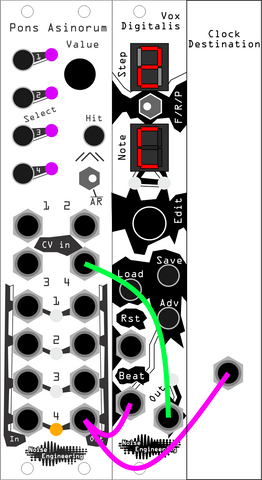In general, we think of clocks as a static, repeating signal. They don’t have to be, though, and we can make them a whole lot more interesting! Today, let’s take a look at some interesting techniques for clocking that are, well, really weird.
Note that all of these techniques will only work with sequencers that advance on a trigger, like the suite of NE sequencers, including the Repetitors (both Numeric and Zularic), Mimetic Digitalis, etc. Some sequencers in Eurorack create an internal clock based off of the input rate, though, so these techniques won’t work with those.

Swing
This is a pretty standard concept, but unless it’s built into your sequencer, you’ll need to patch it up. And here’s how you can do that! We talked about a patch similar to this in our post about making oddly timed sequences; here we’ll be using a simplified version of that technique. To recap: we need a voltage-controlled clock (or LFO in this case, like Pons Asinorum) and a CV sequencer. Vox Digitalis is perfect for CV in this case: we can set its sequence length to 2, and set the first step to be a higher voltage than the second. Patch the CV out into the PA, patch the PA out into the clock in on the VD, and you have a swung clock. Here’s what that patch looks like:
Learn more:
Let’s try this out. Here, we’ve created a swung clock and we’re using it to run Mimetic Digitalis, sequencing Basimilus Iteritas through the upcoming Desmodus Versio.
Glitchy/randomized/irregular clocks
One of my absolute favorite things to do when sequencing is to have strange clocks driving my sequencers, but regular resets. This means that your measures always start in the same place, but all sorts of craziness can happen in the middle. First, we need our reset signal. Run a copy of your unmodified clock into a divider; generally, I like to use a /16 division to get a reset every measure in 4/4, but whatever suits your taste will work. Then, we run another copy into something that will make it weirder. The simplest example will be something that will put probability onto the trigger, like our old Integra Funkitus. You could also use something more irregular, like Mimetic Multium, for completely random clocks, or, and this is my favorite, you could combine multiple signals together in an OR gate (or a unity mixer) to create completely crazy, glitchy clocks. A random gate generator, burst generator, or something else like that mixed in with a regular clock creates what is basically instant IDM.
Check it out! Here, we’re using Integra Funkitus to skip about half our clock signals. We then run that clock into Mutable Instruments Branches, which sometimes triggers a 2hp Brst. Our skipped clock and bursts are combined with Quantus Pax, and that sequences the same MD/BIA patch we had before.
Ritardandos/accelerandos
Something that is often left out of electronic music completely is use of tempo as an expressive control. While that’s easy to do when, say, playing the piano, it can be a bit harder in an electronic performance. So let’s change that!
Remember in our first example when we sequenced a clock with CV? That also means that we can manually control our clock speed in a performance. I like to use something like Lapsus Os for this. We could use the same setup as before with a looping PA as our clock, but some sequencers and clock generators have CV over clock built-in, which makes it easier. Remember, you can use any LFO with CV control as your clock, too.
Set PA (or your other CV-able clock source) to the slowest you’ll want your tempo. Patch a channel of LO in unipolar mode out to an attenuator like Sinc Defero or whatever you have on hand, and patch the attenuator’s output to the CV input on on your clock. Max out the LO channel, and then turn the attenuator down until the clock is as fast as you’ll want it to be. Now, as your sequence is playing, you can shift the clock speed around by moving the LO slider up and down.
Conversely, we can sequence clock changes in a slower way, too: if you have a slew limiter and a CV sequencer in your system, you can easily create long accelerandos or ritardandos (fancy classical music speak for “speeding up” and “slowing down”, respectively) by CVing your clock with those. Or, you can use a clocked modulation source like Clep Diaz to create regular, smooth tempo changes throughout a patch.






